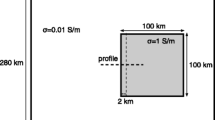Abstract
The influence of anisotropic conductivity structures on magnetotelluric transfer functions is not easy to analyse in its entire complexity. In this study, we investigate the spatial and frequency-dependent behaviour of phase tensors and tipper vectors above a 3D anisotropic conductivity anomaly. The anomaly consists of a simple cubic block embedded in a homogeneous half space. Using a 3D FD code, we compare an isotropic, 2 anisotropic models with an anisotropy factor of 10 and one anisotropic model with the anisotropy factor of 100. The results show characteristic differences between the isotropic and anisotropic cases. For the anisotropic anomalies, the tipper vectors are parallel over the entire area despite the 3D geometry of the anomalous body. The size of the tipper vectors depends on the position of the site relative to the anomaly’s boundaries and the direction of the anisotropic strike. Above the anomalous anisotropic body, the main diagonal elements of the phase tensor show the well-known split. Outside the anomaly, the phase tensor principal axis rotates according to the site position in contrast to the constant tipper direction. The 3D inversion of the forward data using an isotropic 3D code (ModEM) yields a very good fit for all cases. Whereas the inversion result matches the isotropic model, wave-like structures with high conductivity contrast occur for the anisotropic models. These structures extend far beyond the extension of the original anomalous body. Thus, the study reveals important indications of the existence of anisotropic conductivity structures for observed magnetotelluric transfer functions.








Similar content being viewed by others
References
Caldwell, T. G., Bibby, H. M., & Brown, C. (2004). The magnetotelluric phase tensor. Geophysical Journal International, 158, 457–469.
Eisel, M., & Haak, V. (1997). Macro-anisotropy of the electrical conductivity of the crust: a magnetotelluric study of the German Continental Deep Drilling site (KTB). Geophysical Journal International, 136, 109–122.
Häuserer, M., & Junge, A. (2011). Electrical mantle anisotropy and crustal conductor: a 3-D conductivity model of the Rwenzori Region in western Uganda. Geophysical Journal International, 185, 1235–1242.
Heise, W., Caldwell, T. G., Bibby, H. M., & Brown, C. (2006). Anisotropy and phase splits in magnetotellurics. Physics of the Earth and Planetary Interiors, 158, 107–121.
Heise, W., & Pous, J. (2001). Effects of anisotropy on the two-dimensional inversion procedure. Geophysical Journal International, 147, 610–621.
Jones, A. G. (2012). Distortion decomposition of the magnetotelluric impedance tensors from a one-dimensional anisotropic Earth. Geophysical Journal International, 189, 2012.
Kelbert, A., Meqbel, N., Egbert, G. D., & Tandon, K. (2014). ModEM: A modular system for inversion of electromagnetic geophysical data. Computers & Geosciences, 66, 40–53.
Martí, A. (2013). The role of electrical anisotropy in magnetotelluric responses: From modelling and dimensionality analysis to inversion and interpretation. Surveys in Geophysics, 23, 179–218.
Martí, A., Queralt, P., Ledo, J., & Farquharson, C. (2010). Dimensionality imprint of electrical anisotropy in magnetotelluric responses. Physics of the Earth and Planetary Interiors, 182, 139–151.
Martinelli, P., & Osella, A. (1997). MT forward modeling of 3-D anisotropic electrical conductivity structures using the Rayleigh-Fourier method. Journal of Geomagnetism and Geoelectricity, 49, 1499–1518.
Pankratov, O. V., Kuvshinov, A. V., & Avdeev, D. B. (1997). High-performance three-dimensional electromagnetic modelling using modified Neumann series. Anisotropic Earth. Journal of Geomagnetism and Geoelectricity, 49, 1541–1547.
Pek, J., & Verner, T. (1997). Finite-difference modelling of magnetotelluric fields in two-dimensional anisotropic media. Geophysical Journal International, 128, 505–521.
Wang, T., & Fang, S. (2001). 3-D electromagnetic anisotropy modeling using finite differences. Geophysics, 66(5), 1386–1398.
Weidelt, P. (1999). 3-D conductivity models: implications of electrical anisotropy. In M. Oristaglio & B. Spies (Eds.), Three-dimensional electromagnetics (pp. 119–137). Tulsa: SEG.
Weidelt, P., & Chave, A. D. (2012). The magnetotelluric response function. In A. D. Chave & A. G. Jones (Eds.), The magnetotelluric method—theory and practice (pp. 122–164). Cambridge: Cambridge University Press.
Weiss, C. J. (2012). The two- and three-dimensional forward problems. In A. D. Chave & A. G. Jones (Eds.), The magnetotelluric method—theory and practice (pp. 303–346). Cambridge: Cambridge University Press.
Weiss, C. J., & Newman, G. A. (2002). Electromagnetic induction in a generalized 3D anisotropic earth. Geophysics, 67(4), 1104–1114.
Weiss, C. J., & Newman, G. A. (2003). Electromagnetic induction in a generalized 3D anisotropic earth, Part 2: The LIN preconditioner. Geophysics, 68(3), 922–930.
Wiese, H. (1962). Geomagnetische Tiefensondierung. Teil II: Die Streichrichtung der Untergrundstrukturen des elektrischen Widerstandes, erschlossen aus geomagnetischen Variationen—Geofis. Pura et Applicata, 52, 83–103.
Author information
Authors and Affiliations
Corresponding author
Rights and permissions
About this article
Cite this article
Löwer, A., Junge, A. Magnetotelluric Transfer Functions: Phase Tensor and Tipper Vector above a Simple Anisotropic Three-Dimensional Conductivity Anomaly and Implications for 3D Isotropic Inversion. Pure Appl. Geophys. 174, 2089–2101 (2017). https://doi.org/10.1007/s00024-016-1444-3
Received:
Accepted:
Published:
Issue Date:
DOI: https://doi.org/10.1007/s00024-016-1444-3




